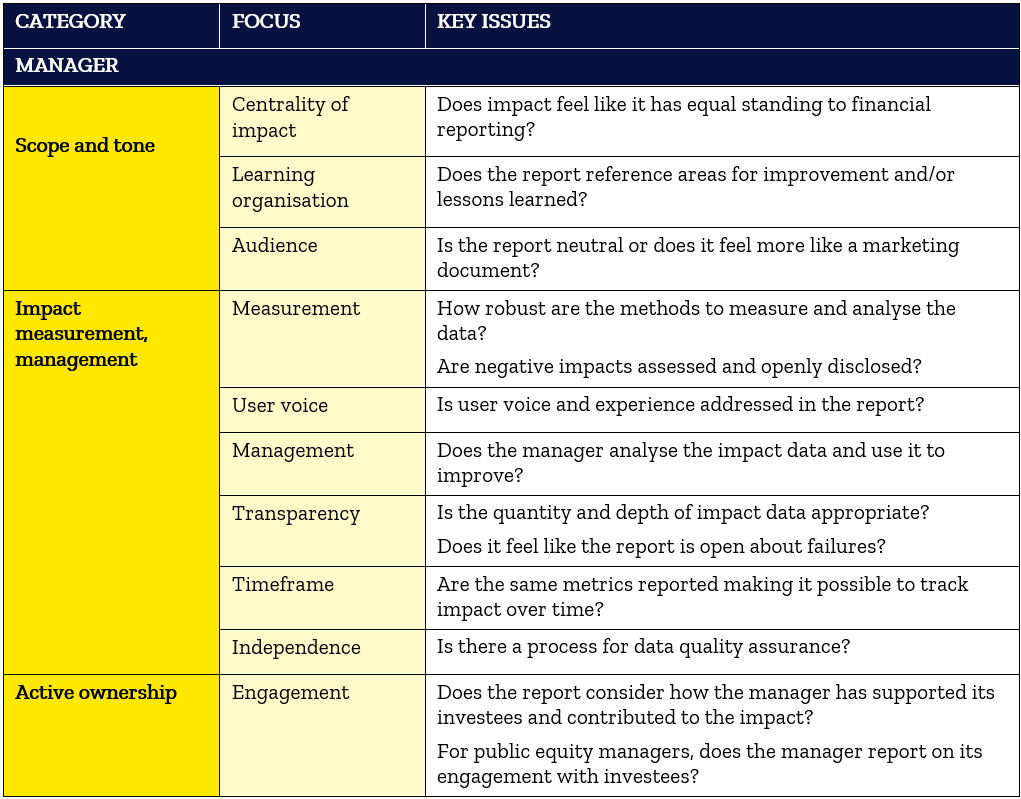How to read an impact report.
Dec 03 2021 · 5 minute read
The third sector has been working hard on evidencing the difference that it makes for decades. Impact investors can learn from their experience and the sector’s use of theories of change, stakeholder feedback and outcome metrics.
This is the lens from which Snowball reads an impact report: we look for the understanding, tracking and analysis of impact data so that impact can be improved over time. So, we focus on our managers’ learning and improvement as we read an impact report – rather than just lives touched and Greenhouse Gas emissions avoided.
A good example is the recent impact report by Impax which reports on the net CO2 impact of each of its strategies. This includes an analysis of each holding’s CO2 emissions and how much has been avoided against the industry benchmarks. Reporting on these in unison gives confidence that Impax really understand the issues and that it can therefore make investment, allocation and engagement decisions based on a more nuanced perspective of a company’s environmental impact.
We developed a framework for analysing impact reports based on the work of Social Value Canada and Social Value US. A high-level summary is shown in the table below split into three sections – scope and tone, impact process and active engagement.

Scope and tone analyses whether impact reporting is produced solely for accountability rather than improvement purposes. Is the report more of a marketing document and lacking any reflection? Is the impact report focussing on the key impacts?
Key impacts will vary from company to company. Within our portfolio we have impact KPIs that include the number of days children are kept out of care, the percentage of a school menu that is reformulated each term, the number of sustainable packaging trays sold and the number of families accessing quality stable accommodation. Impact KPIs that matter are often unique to that business and that is where their true value lies. So, we should resist the temptation to find other less important KPI’s for convenience.
Impact measurement and management analyses if the manager is collecting consistent and useful impact data in a rigorous manner and using it to improve. Is the voice and experience of the user being considered in this process? As a reader can I track this improvement?
Impact implies change and therefore two measurements are required to evidence change. Hence the importance of collecting consistent data frequently that can be used to improve. This is not evaluation data but feedback data – and therefore may be an outcome rather than an impact. But data that doesn’t help a company to improve is not going to be a priority for the company. From our portfolio, we have seen this work well through a detailed analysis of the positive impact of Grover’s flexible rental model to identify the number of “virgin units of manufacture avoided”. Tracking this KPI helps Grover communicate its impact and increase it over time. We look for reporting that comprises longitudinal data as well as case studies that shed light on the user experience.
Active ownership analyses if the manager is engaging with their underlying investments and whether this engagement leads to improved outcomes.
Active ownership differs across asset classes, and between public and private markets. We take this into account when reading impact reports and have different expectations. But irrespective of the above we do want to see evidence of change as a result of active ownership – an area that public equity particularly struggles with. Voting and engagement statistics without an assessment of success are pretty pointless. Our hope is that public equity managers become more successful in their engagement – and communicate it. Fixed income fund managers, despite their lack of equity, can also engage actively – but unfortunately, we don’t see much (if any) reporting on this.
From looking at an impact report from these three perspectives we can begin to understand more about the manager’s approach to impact investing and whether we will make good partners. We are fortunate that the majority of our managers are open to the feedback that we provide through a completed scorecard.
Going forward we hope to see more impact reporting sitting alongside financial reporting. We expect impact investing to become the norm as investors and savers alike realise that investing can generate market returns alongside social and environmental impact.
If you have any thoughts about this article or would like to learn more about Snowball, please email us at hello@snowball.im.
